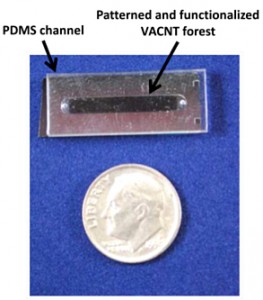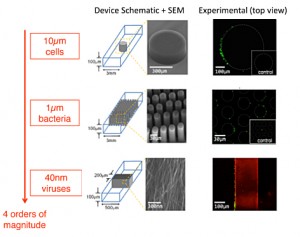Nanoporous Elements in MEMS with a Focus on Microfluidic Bioparticle Separation
- Category: Nanotechnology
- Tags: Brian Wardle, Fabio Fachin
We integrated ultra-porous (99% porous) elements composed of nanoporous forests of vertically aligned carbon nanotubes (VACNTs) in MEMS, demonstrating their use in microfluidic applications for bioparticle isolation and health diagnostics. Distinct from prior works where the effects of fluids on VACNT elements would result in either structural deformation or catastrophic forest collapse [1] , the approach here enables creation of high aspect ratio (~ 1-mm in height) nanoporous elements and preserves their shape even under flow-through conditions. An example device, shown in Figure 1, consists of a patterned and (wet) functionalized VACNT forest integrated into a PDMS microfluidic channel.
Compared to state-of-the-art designs that exploit solid materials (e.g., silicon, PDMS) for the structural features, our nanoporous elements enables fluid flow both around and through the VACNT elements, thus enhancing physical interaction between the particles in the flow and the functional elements. A ~7X increase in specific bioparticle capture when transitioning to VACNT porous designs was demonstrated for multiple device layouts [1] . The large surface-to-volume ratio of nanoporous materials yields also a significant increase in functional surface area (~250-500X for the layouts analyzed in our works [2] [3] ), thus further promoting bioparticle capture.
Specific isolation of bioparticles ranging over 4 orders of magnitude in size (from cells to viruses) was experimentally demonstrated (Figure 1), including the ability to perform simultaneous multiphysics, multiscale isolation on a single chip. Particles smaller than the average distance between single nanotubes in the VACNT elements (~80 nm) can penetrate the elements and can be isolated using chemical affinity; simultaneously, particles larger than 80 nm cannot enter the nanoporous elements and can be isolated on the elements’ outer surfaces using both mechanical filtration and biomolecular recognition. The nanoporous elements are versatile and could provide access to underexplored sub-micron particles (e.g., proteins, exosomes).
- D. N. Futaba, K. Hata, T. Yamada, T. Hiraoka, Y. Hayamizu, Y. Kakudate, O. Tanaike, H. Hatori, M. Yumura, and S. Iijima. “Shape-engineerable and highly densely packed single-walled carbon nanotubes and their application as super-capacitor electrodes,” Nature Materials, vol. 5, pp. 987-994, 2006. [↩] [↩] [↩]
- G. D. Chen, F. Fachin, M. Fernandez-Suarez, B. L. Wardle, and M. Toner, “Nanoporous elements in microfluidics for multiscale nanipulation of bioparticles,” Small, vol. 7, pp. 1061-1067, 2011. [↩] [↩]
- F. Fachin, G. D. Chen, M. Toner, and B. L. Wardle, “Integration of vertically-aligned carbon nanotube forests in microfluidic devices for multiscale isolation of bioparticles,” Proc. IEEE Sensors 2010, Kona, HI, pp. 47-51. [↩]

